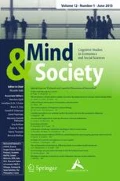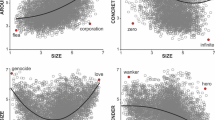Abstract
We here report the findings of our investigation into the validity of the “conjunction fallacy” (Tversky & Kahneman, 1983), bearing in mind the role of conversational rules. Our first experiment showed that subjects found a logically correct answer unacceptable when it implied a violation of the conversational rules.
We argue that tautological questions, such as those which concern the relationship of inclusion between a class and its sub-class, violate conversational rules because they are not informative. In this sense, it is not understood that the question in a Linda-type problem involves a comparison between an inclusive and included class, but presumed that a different type of comparison is intended.
Tautological questions (and, consequently, also their answers) do not become a matter of discussion except under certain specific conditions. Our second experiment showed that, providing the context was adequately marked (such as in the case of a rhetorical question), the conjunction fallacy disappears.
In two further experiments, the implications of our view were compared with those of the other critical approaches to the heuristic programme: the classical pragmatic view (which we call logical complementarity) and the frequentist view.
Similar content being viewed by others
References
Adler, J.E. (1984). Abstraction is uncooperative,Journal for the Theory of Social Behavior, 14, pp. 165–181
Agnoli, F. (1991). Development of judgmental heuristics and logical reasoning: Training counteracts the representativeness heuristic,Cognitive Development, 6, pp. 195–217.
Bar-Hillel, M. & Neter, E. (1991). How alike is it versus how likely is it: A disjunction fallacy in probability judgments,Communication presented at the SPUDM (Freiburg).
Brainerd, C.J. & Reyna, V.F. (1991). Inclusion illusions: Fuzzytrace theory and perceptual salience effects in cognitive development,Developmental Review, 10, pp. 365–403.
Carlson, B.W. & Yates, J.F. (1989). Disjunction errors in qualitative judgment,Organizational Behavior and Human Processes, 44, pp. 368–379.
Chapman, L.J. & Chapman, J.P. (1955). Atmosphere effect re-examined,Journal of Experimental Psychology: General, 58, 3, pp. 220–226.
Dulany, D.E. & Hilton, D.J. (1991). Conversational implicature, conscious representation, and the conjunction fallacy,Social Cognition, 9 (1), pp. 85–110.
Fernandez-Berrocal, P., Almaraz, J. & Segura, S. (1996). How to reconsider the base rate fallacy without forgetting the concept of systematic processing,Behavioral and Brain Sciences 19, 1, pp. 21–22.
Fiedler, K. (1988). The dependence of the conjunction fallacy on subtle linguistic factors.Psychological Research, 50, pp. 123–129.
Gigerenzer, G. (1991). On cognitive illusion and rationality. In E. Eells & T. Maruszewski (Ed.),Reasoning and rationality. Essays in honour of L.J. Cohen (Amsterdam, Rodopi).
Gigerenzer, G. (1995). Why the distinction between single-event probabilities and frequencies is relevant for psychology (and vice versa). In G. Wright & P. Ayton (Eds.),Subjective probability, pp. 129–162 (New York, Wiley).
Grice, H.P. (1975). Logic and conversation. In P. Cole & J.L. Morgan (Eds.),Syntax and Semantics: Vol. 3. Speech acts (New York, Academic Press).
Hertwig, R. & Gigerenzer, G. (1999). The “conjunction fallacy” revisited: How intelligent inferences look like reasoning errors,Journal of Behavioral Decision Making, 12, pp. 275–305.
Johnson-Laird, P., Legrenzi, P. & Sonino Legrenzi, M. (1972). Reasoning and a sense of reality,British Journal of Psychology, 63, pp. 395–400.
Jones, S.K., Taylor, K. & Frisch, D. (1995). Biases of probability assessment: A comparison of frequency and single-case judgments,Organizational Behavior and Human Decision Processes, 61, pp. 109–122.
Kahneman, D. (1991). Judgment and decision making. A personal view.Psychological Science, 2, 3, pp. 142–45.
Kahneman, D., Slovic, P. & Tversky, A. (Eds.) (1982).Judgment under uncertainty: Heuritics and biases (Cambridge, Cambridge University Press).
Kahneman, D. & Tversky, A. (1972). Subjective probability: A judgment of representativeness.Cognitive Psychology, 3, pp. 430–454.
Leddo, J., Abelson, R.P. & Gross, P.H. (1984). Conjunctive explanation: When two reasons are better than one,Journal of Personality and Social Psychology, 47, pp. 933–943.
Locksley, A. & Stangor, C. (1984). Why versus often: Causal reasoning and the incidence of judgmental bias,Journal of Experimental Social Psychology, 20, pp. 470–483.
Macchi, L. (1995). Pragmatic aspects of the base rate fallacy,The Quarterly Journal of experimental Psychology, 48A (1), pp. 188–207.
Macchi, L. (2000). Partitive formulation of information in probabilistic problems: Beyond heuristics and frequency format explanations,Organizational Behavior and Human Decision Processes, 82, pp. 217–236.
Macdonald, R.R. (1986). Credible conceptions and implausible probabilities.British Journal of Mathematical and Statistical Psychology, 39, pp. 15–27.
Marcisrewski, W. (1981).Dictionary of logic, as applied in the study of language (Murlinus, Mijhoff Publishers).
Morier, D.M. & Borgida, E. (1984). The conjunction fallacy: A task specific phenomenon?,Personality and social Psychology Bulletin, 10, pp. 243–52.
Mosconi, G. (1966). Contributo all’analisi psicologica delle qualità espressive,Rivista di Psicologia, IV, pp. 337–351.
Mosconi, G. (1990).Discorso e pensiero (Bologna, Il Mulino).
Mosconi, G. & D’Urso, V. (1974).Il farsi e il disfarsi del problema (Firenze, Giunti-Barbera).
Mosconi, G. & Macchi, L. (1996). Pragmatic factors in the conjunction fallacy,Communication presented at the 3rd International Conference on Thinking, British Psychological Society Cognitive Section, 29–31 August.
Piaget, J. & Szeminska, A. (1941).La Génèse du nombre chez l’enfant (Neuchatel, G.N.).
Politzer, G. & Noveck, I.A. (1991). Are conjunction rule violations the result of conversational rule violations?Journal of Psycholinguistic research, 20, 2, pp. 83–104.
Reeves, T. & Lockhart, R.S. (1993). Distributional versus singlular approaches to probability and errors in probabilistic reasoning,Journal of Experimental Psychology: General, 122, pp. 207–226.
Sapir, E. (1944). Grading: A study in semantics,Philosophy of Science, 11, pp. 93–116.
Sells, S.B. (1936). The atmosphere effect. An experimental study of reasoning,Archiv Psychology, 28, pp. 514–518.
Shafir, E.B., Smith, E.E. & Osherson, D.N. (1990). Typicality and reasoning fallacies.Memory and Cognition, 18, pp. 229–239.
Shipley, E.F. (1979). The class-inclusion task: Question form and distributive comparisons,Journal of Psycholinguistic Research, 8, pp. 301–331.
Sperber, D. & Wilson, D. (1986).Relevance. Communication and cognition (Oxford, Basil Blackwell).
Tversky, A. & Kahneman, D. (1973). Availability: A heuristic for judging frequency and probability.Cognitive Psychology, 4, pp. 207–232.
Tversky, A. & Kahneman, D. (1982). Judgments of and by representativeness. In D. Kahneman, P. Slovic & A. Tversky (Eds.),Judgment under uncertainty: Heuristics and biases (Cambridge, Cambridge University Press).
Tversky, A. & Kahneman, D. (1983). Extensional versus intuitive reasoning: The conjunction fallacy in probability judgment,Psychological Review, 90, pp. 293–315.
Wells, G.L. (1985). The conjunction error and the representativeness heuristic,Social Cognition, 3, pp. 266–279.
Winer, G.A. (1974). An analysis of verbal facilitation of class-inclusion reasoning,Child Development, 45, pp. 224–227.
Woodsworth, R.S. & Sells, S.B. (1935). An atmosphere effect in formal syllogistic reasoning,Journal of Experimental Psychology, 18, pp. 451–460.
Yates, J.F. & Carlson, B.W. (1986). Conjunction errors: Evidence for multiple judgement procedures, including “signed summation”,Organizational Behavior and Human Decision Processes, 37, pp. 230–253.
Author information
Authors and Affiliations
Rights and permissions
About this article
Cite this article
Mosconi, G., Macchi, L. The role of pragmatic rules in the conjunction fallacy. Mind & Society 2, 31–57 (2001). https://doi.org/10.1007/BF02512074
Received:
Accepted:
Issue Date:
DOI: https://doi.org/10.1007/BF02512074




